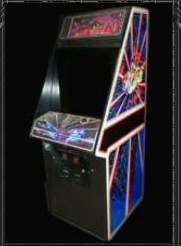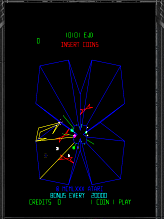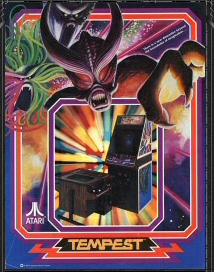Tempest
So just what is Tempest?
At 25 years old, Tempest is an exercise in pure
abstract gaming that dates way back to 1981. It
was, for me at least, the first "hardcore"
game that I had ever played and marked a real
turning point in the arcade experience. Other
arcade games before then were very primitive in
design terms, and lacked what I would call "pure"
gameplay. And this is where Tempest stands out
... simple, elegant and hugely addictive - it
made you feel like a real bad-ass gamer. In short,
in 1981, Tempest rocked the arcade scene.
Nowadays, I'm lucky enough to actually own a
genuine Tempest arcade machine here at home. God
has truly been kind to me.
Trivia quoted from MAME history
Tempest was an awesome arcade game that transported
the player into abstract realms of space. Soaring
into its third decade of life, Tempest is still
the favorite of devotees who seek to become one
with this adventure through hyperspace. Approximately
29,900 units were produced. Tempest sold approximately
20,000 units to distributors before it was even
released.
 Tempest
was the first game to use 'Color-Quadrascan' and
'Skill-Step', both features unique to Atari vector
games. Tempest was originally a 3-D "Space
Invaders" clone called 'Vortex', but was
changed when the other engineers didn't come back
to play the game. This was kind of a test for
an Atari game; if the engineers kept coming back
to play a new game, it was considered a hit. Tempest
was the first game to use 'Color-Quadrascan' and
'Skill-Step', both features unique to Atari vector
games. Tempest was originally a 3-D "Space
Invaders" clone called 'Vortex', but was
changed when the other engineers didn't come back
to play the game. This was kind of a test for
an Atari game; if the engineers kept coming back
to play a new game, it was considered a hit.
The first prototype of the game had the shape
wireframe spinning and the gunner remaining stationary,
but that caused motion sickness after a period
of time so it was changed around.
The Creation of Tempest:
Dave Theurer, who designed the game and wrote
the software, said his original intention was
to make a first-person perspective of the "Space
Invaders" game, but he ended up doing something
completely new and different. Rich Adam: "Dave
implemented a first-person "Space Invaders".
Everybody played it but they didn't keep coming
back. You could tell when you had something cool,
the engineers kept coming back. This was good
and bad because there were times when you wanted
to work on your game and everybody would want
to be playing it. But when he was doing the first-person
"Space Invaders", Dave didn't run into
this problem of everyone wanting to play the game...
and he said to himself: 'Well, maybe this isn't
working. What can I do?' Then I came in one day
and all of a sudden he had this round tube with
these things coming up it. I said, 'What the heck
is that Dave?' He said, 'I don't know. Aliens
from the center of the Earth? I don't know.' I
think he said something about having had a dream
about it. I said, 'How does it work?' He said,
'I don't know. They're coming up around the edge
of this thing and you're trying to blow them away.'
He just sort of started out with this concept
and took it from there. I can see why he would
say that Tempest was certainly his proudest achievement.
He worked extremely hard on that. It's pure creation
from his own brain"
 Remembrances
from the Video Game Masters: Although known
for his hard work and for his ability to focus
on and conquer exceedingly tough software problems,
Dave Theurer looks back upon his days at Atari
as having been fun and rewarding. Dave Theurer:
"It was just so exciting working on these
new games. All my life I loved explosions. When
I went to college I was a chemistry major because
I wanted to do something where I could make explosions.
When I was a kid I had a chemistry set and I'd
blow stuff up all the time. Eventually, you learn
that you can't really do that in real life, so
the next best thing is to do it on the screen,
so here I was blowing stuff up on the screen.
Simulating real life is fun too. It's almost like
you can create your own universe. Well, you are
creating your own universe. That's rewarding,
to see something come alive" Remembrances
from the Video Game Masters: Although known
for his hard work and for his ability to focus
on and conquer exceedingly tough software problems,
Dave Theurer looks back upon his days at Atari
as having been fun and rewarding. Dave Theurer:
"It was just so exciting working on these
new games. All my life I loved explosions. When
I went to college I was a chemistry major because
I wanted to do something where I could make explosions.
When I was a kid I had a chemistry set and I'd
blow stuff up all the time. Eventually, you learn
that you can't really do that in real life, so
the next best thing is to do it on the screen,
so here I was blowing stuff up on the screen.
Simulating real life is fun too. It's almost like
you can create your own universe. Well, you are
creating your own universe. That's rewarding,
to see something come alive"
Playing games, both video and pinball, was a
constant part of life for the engineers at Atari.
Dan Pliskin: "In the morning, I used to go
in and I'd make up a pot of Italian roast or French
roast coffee and pour myself a big mug. Then I'd
go and sit it on a pinball machine and drink coffee
and play pinball until scores got up to, like,
a couple hundred thousand. That would be my indication
that I was sharp enough to go and design something"
 Popular
from the Start: Tempest was a game that
immediately captivated people from the very start.
Lyle Rains: "Like a number of these games
that were very addictive, the Tempest controls
were good enough to where once you learned how
to manipulate them you could almost become one
with the machine. That is, a good Tempest player
gets to spin that knob and do the firing in the
right time and get into sync with the machine
or get into a rhythm. I don't know exactly what
to call it, but you were so close to the action
that part of you entered the experience. You forgot
about what was going on around you and you were
just there. And you could get very good at it.
I think what people like is the ability to accomplish
amazing things" Popular
from the Start: Tempest was a game that
immediately captivated people from the very start.
Lyle Rains: "Like a number of these games
that were very addictive, the Tempest controls
were good enough to where once you learned how
to manipulate them you could almost become one
with the machine. That is, a good Tempest player
gets to spin that knob and do the firing in the
right time and get into sync with the machine
or get into a rhythm. I don't know exactly what
to call it, but you were so close to the action
that part of you entered the experience. You forgot
about what was going on around you and you were
just there. And you could get very good at it.
I think what people like is the ability to accomplish
amazing things"
The Great 25-Cent Escape:
Not only did players often find a sense of welcome
escape in the video games they played, but this
was very much the intention of some of the great
game designers. Dave Theurer: "I want to
design it for a guy who's totally frazzled by
his job and needs a way to temporarily escape.
There's a certain class of games... where you
just get into a trance when you're playing them.
As long as you're in this trance you'll do fine"
 Tempest
was available in three different dedicated cabinets.
An upright, a cabaret, and a cocktail. The upright
machine came in a nice arrow shaped cabinet that
featured one long straight angled line from the
top of the cabinet to the bottom of the control
panel. This design makes it very easy to spot
converted Tempest cabinets. The Tempest marquee
had a whole bunch of glowing purple lines along
with an evil looking crawly thing that looked
like it was coming right at you. The sideart had
kind of a spacey look to it, with a bunch of red
lines radiating out from a central point that
had monsters crawling out of it! The control panel
had more spacey lines and holes graphics, along
with an optical spinner and a pair of fire buttons.
The cocktail version was a black square table
with a woodgrain top. It had red lines and instructions
underneath the glass, with player control panels
on either side. For some reason the monitors on
these were installed butted up against one side,
instead of centered. Both the cocktail and the
upright used a color X-Y monitor. Tempest
was available in three different dedicated cabinets.
An upright, a cabaret, and a cocktail. The upright
machine came in a nice arrow shaped cabinet that
featured one long straight angled line from the
top of the cabinet to the bottom of the control
panel. This design makes it very easy to spot
converted Tempest cabinets. The Tempest marquee
had a whole bunch of glowing purple lines along
with an evil looking crawly thing that looked
like it was coming right at you. The sideart had
kind of a spacey look to it, with a bunch of red
lines radiating out from a central point that
had monsters crawling out of it! The control panel
had more spacey lines and holes graphics, along
with an optical spinner and a pair of fire buttons.
The cocktail version was a black square table
with a woodgrain top. It had red lines and instructions
underneath the glass, with player control panels
on either side. For some reason the monitors on
these were installed butted up against one side,
instead of centered. Both the cocktail and the
upright used a color X-Y monitor.
The default high score screen of "Cyberball
2072" features names of many Atari arcade
games, including TEMPEST.
A Tempest unit appears in the 1982 movie 'Fast
Times at Ridgemont High', in the 1983 movie 'Twilight
Zone - The Movie', in the 1983 movie 'Joysticks',
in the 1984 movie 'Night of the Comet', in the
1986 movie 'Running Scared', in the 1986 movie
'Maximum Overdrive' (A cocktail cabinet) and in
the 1987 movie 'Death Wish 4 - The Crackdown'.
A Tempest unit appears in the music video 'Subdivisions'
by RUSH
Tempest Arcade Machine
Tempest
(12-04-81) [Bulletin] - Atari Tempest documentation
Tempest
(CO-190-01) [New Roms - Program] - Atari Tempest
documentation
Tempest
(DP-190 2nd Printing) [Drawing Package] -
Atari Tempest documentation
Tempest
(TM-190 1st Printing) [Op-Maint-Serv-Parts]
- Atari Tempest documentation
Tempest
(TM-190 2nd Printing) [Op-Maint-Serv-Parts]
- Atari Tempest documentation
Tempest
(TM-195 2nd Printing) [Troubleshooting] -
Atari Tempest documentation
Tempest
[Backdoor Sheet] - Atari Tempest documentation
Wells-Gardner
6100 XY Quadrascan (TM-183) [Serv-Schem-Part]
- Atari monitor documentation
Wells-Gardner 6100
Monitor FAQ - First class FAQ for the monitor
most Tempest machines use
Rocket
Ranch - An excellent Tempest fan site
Tempest Derivatives
Tempest
1000 - Free Java version of Tempest
Tempest
2000 - Free version of the original Tempest
2000 released in 1995
Tsunami
2010 - Free version of a new Tempest derivative
released in 2003
|


